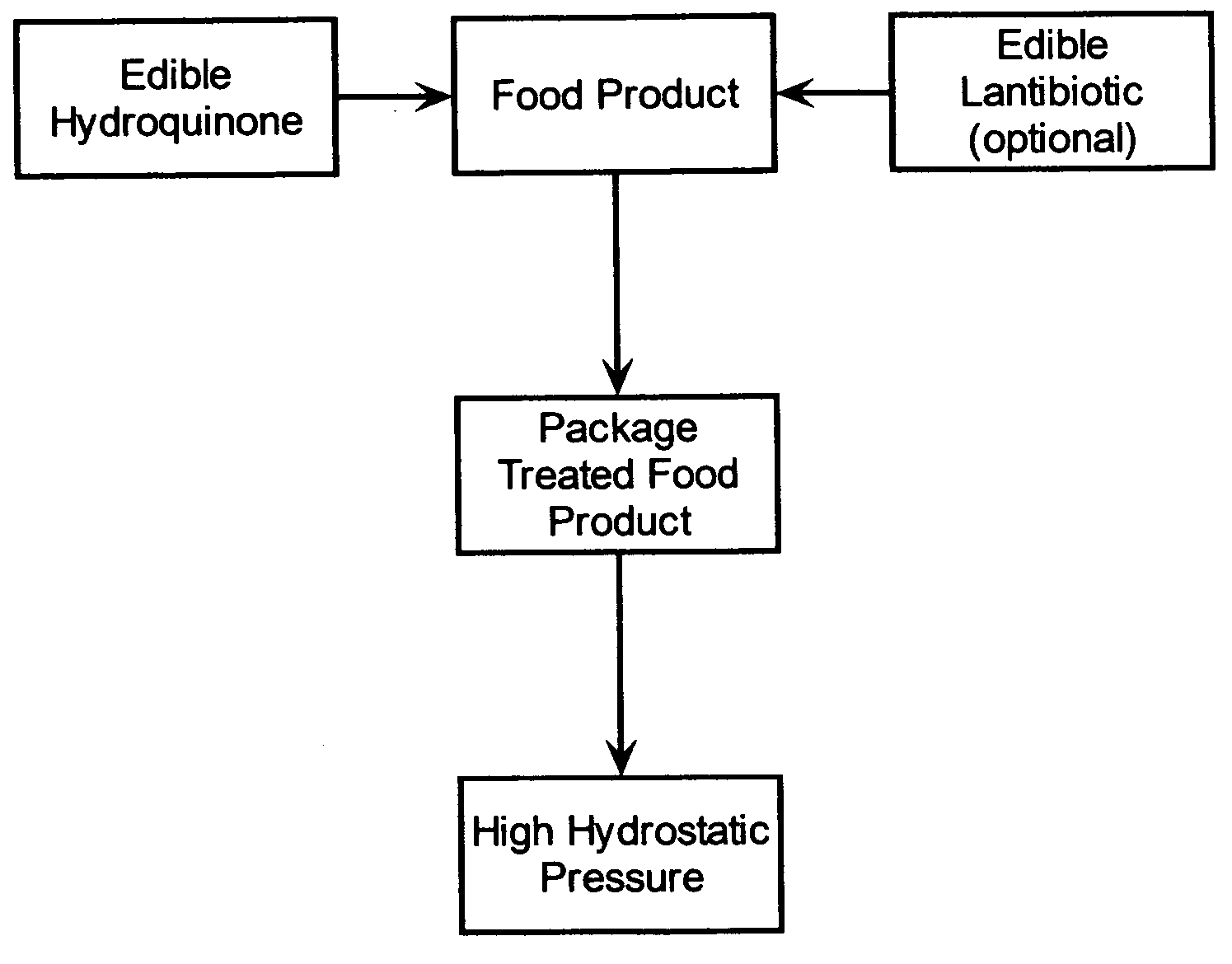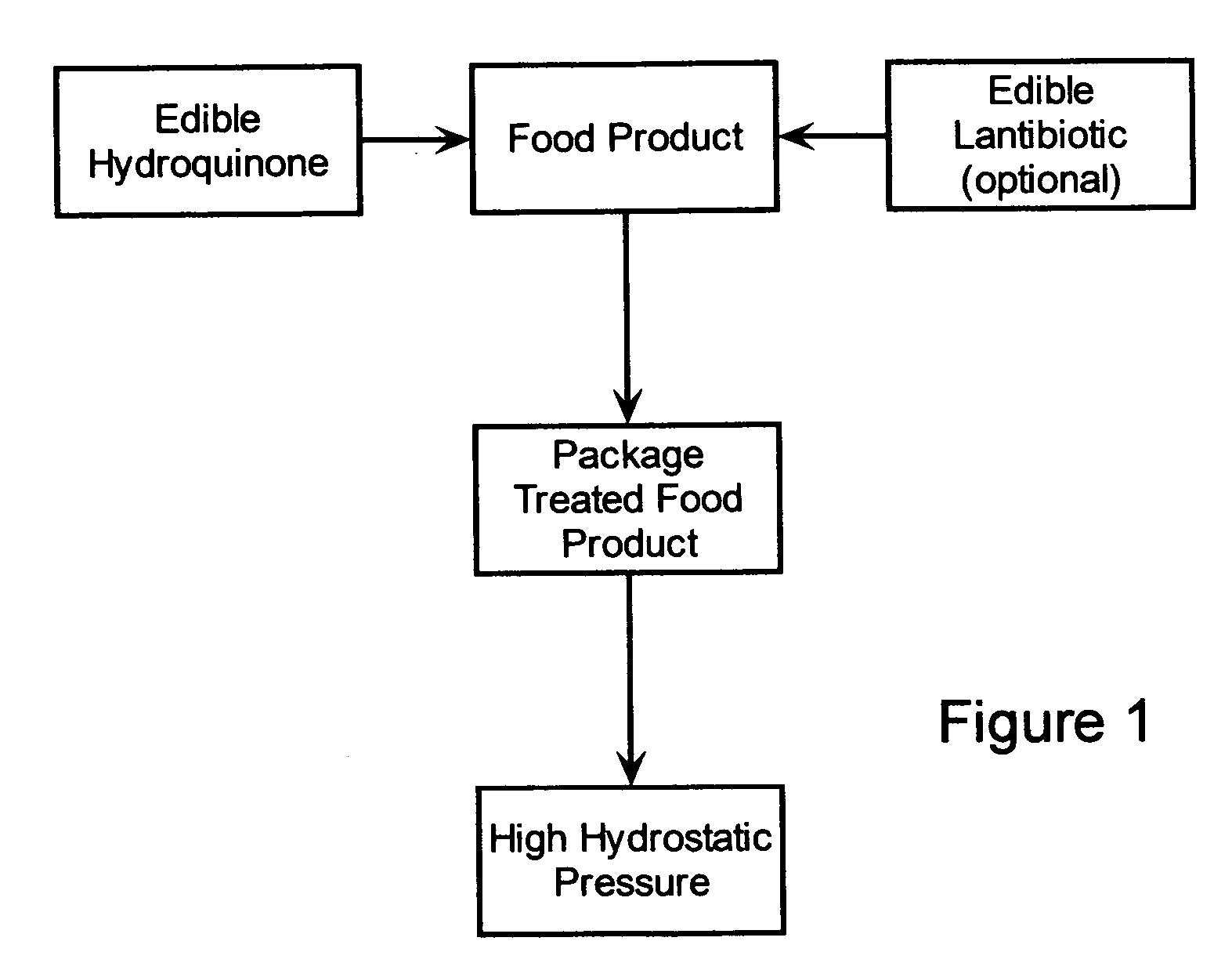Methods for preserving food products
a technology for food products and methods, applied in the field of food preservation, can solve the problem of synergistic greater reduction of microbial activity obtained with this combined treatment, and achieve the effect of reducing microorganisms in food products, efficient and economical treatment, and robust microbial reduction
- Summary
- Abstract
- Description
- Claims
- Application Information
AI Technical Summary
Benefits of technology
Problems solved by technology
Method used
Image
Examples
example 1
[0046] The treatment of sausages inoculated with different strains of Listeria monocytogenes was investigated using various combinations of physical (hydrostatic pressure) and chemical (edible hydroquinone and / or lantibiotic) treatments.
[0047] The edible hydroquinone was tert-butylhydroquinone (TBHQ) at a level of either 0 or 100 ppm. The tert-butylhydroquinone was a food grade material obtained from Sigma Chemical Co. (St. Louis, Mo.). The lantibiotic was nisin at a level of either 0 or 100 IU / g. The nisin used was either pure nisin or a commercial nisin (Nisaplin®), both from Aplin & Barrett, Ltd. (Trowbridge, England). The Nisaplin® sample used contained about 1×106 IU nisin / g (equivalent to about 25 mg nisin / g). Nisin samples were prepared by dissolving nisin powder in distilled water, adjusting the pH to 2 with HCl, and sterilizing at 121° C. for 10 minutes. Samples were prepared and used on the same day for each experiment.
[0048] Three strains of Listeria monocytogenes were ...
example 2
[0053] Treatment conditions required for essentially total elimination of L. monocytogenes were determined using essentially the same materials and procedures as used in Example 1 except that the nisin level was 0, 100, or 200 IU / g; the hydroquinone level was 0, 100, 200, or 300 ppm; and each experiment was repeated 3 times. The results are shown in Table 2.
TABLE 2Average percentages of bagged sausage samples testing positive forlisteria monocytogenes. Inoculated Samples (about 106 CPU Listeriaper g of product) treated for about 5 minutes under various conditions.Standard deviations (S.D.) Are provided in parentheses.Percentage of Bags TestingTreatment ConditionsPositive For Listeria in BatchPressureNisinTBHQof 3 (±S.D.)Run(MPa)(IU / g)(ppm)Scott AOSY-8578OSY-328900010010010010003001001001001101002001006010012020020010025100130200100100100100146000080 (±20)87 (±23)93 (±12)156000300000166001002000001760020020000018600200100000
[0054] No Listeria was detected in the inventive method (r...
example 3
[0055] Three strains of Listeria monocytogenes identified in Example 1 were grown in tryptose broth for 18 hours at 37° C. Cultures were centrifuged at 10,000 rpm for 15 minutes at 4° C. Cell pellets were resuspended in phosphate buffer (pH 7.0) and the cell population of each strain was adjusted to 109 CFU / ml. Tert-butylhydroquinone was added at about 100 ppm (10% vol / vol TBHQ / culture). Preparation of sample bags and the high pressure treatment procedures were same as indicated in Example 1. Pressures tested were 300, 500, and 700 MPa. Control and high pressure-treated treated samples were serially diluted in 0.1% peptone water and spread-plated on tryptose agar. The plates were incubated at 37° C. for 48-72 hours and the colonies were counted. High pressure processing parameters for these runs and the results are listed in Table 3.
TABLE 3Average log reduction for Listeria Monocytogenes strains (initial load of about 106 cfu / ml)in phosphate buffer after pressure treatment in the ...
PUM
 Login to View More
Login to View More Abstract
Description
Claims
Application Information
 Login to View More
Login to View More - R&D
- Intellectual Property
- Life Sciences
- Materials
- Tech Scout
- Unparalleled Data Quality
- Higher Quality Content
- 60% Fewer Hallucinations
Browse by: Latest US Patents, China's latest patents, Technical Efficacy Thesaurus, Application Domain, Technology Topic, Popular Technical Reports.
© 2025 PatSnap. All rights reserved.Legal|Privacy policy|Modern Slavery Act Transparency Statement|Sitemap|About US| Contact US: help@patsnap.com


